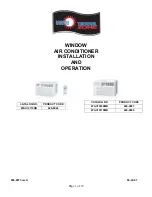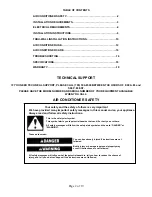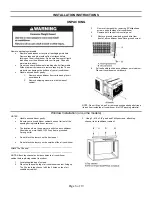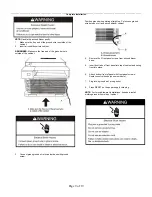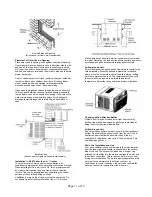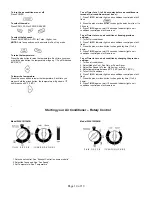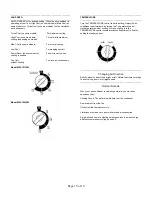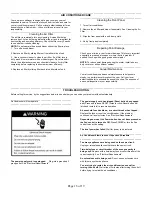
Page 11 of 19
Framed/Finished Opening
(brick veneer or frame wall construction)
Placement of Outer Case in Opening
Place outer case in opening, flush against one side of opening.
Use carpenter’s level and ensure case is level from side to side
and has a 3/8” slope from front to back (back of case must be
3/8” lower than front to ensure proper condensate drainage). If
needed, use shims to level case (from side to side and to obtain
proper back slope.
Front of case must project ¾ inch (minimum) beyond inside wall
in order to attach air conditioner front fame. If framing indoor
side of opening with wood molding (or other decorative
material), extend outer case ¾” beyond molding.
When case is properly positioned in opening, use wood shims
to fill any gaps between case and finished opening, especially
in area where case will be secured to opening. Take care not to
warp or distort case when installing shims. For condensate
drainage, install drainage cup in drain hole on base-plate of
case.
Installed Case
(brick veneer or frame wall construction shown)
Installation in Wall Thicker than 8 – ½ inches
The side louvers in outer case provide ventilation to air
conditioner compressor and fan motor and must not be blocked.
When installing unit in a wall over 9 3/8” thick, provisions must
be made in wall opening to ensure free air flow to the side
louvers. This can be accomplished by chamfering the vertical
portions of the outside opening as shown.
Ventilation louvers on top of case must not be obstructed. Do
not attempt to install unit in walls thicker than 11-3/4 inches.
While operation of all units is similar, controls very from model
to model. Operating Controls section shows control panel of unit
purchased and gives detailed information about controls.
Airflow around Unit
Select the highest fan speed and set temperature control to its
coldest position. When the desired temperature is reached,
slowly move the temperature control toward a warmer setting
until the compressor shuts off. The thermostat will then cycle
the compressor on and off to maintain this selected
temperature. Adjust the fan speed for desired air circulation.
Changing airflow Direction Baffles
Airflow on unit may be diverted left or right from center by
baffles. Upward and downward air discharge is provided by
tilting louvers for desired airflow pattern.
Airflow Around Unit
Check the indoor grill and outdoor louvers for obstructions to
airflow. Do not block the airflow to and from the unit. If air is
obstructed and/or deflected back into the unit, the air
conditioner’s compressor may cycle off and on rapidly. This
could damage your unit.
Drain Cup Installation and Use
Your air conditioner uses a system where the water removed
from the indoor air (condensate) is channeled to the outdoor
side of the unit. The outdoor fan blade has a “slinger” ring
attached to it that dips into the water and slings the water onto
the outdoor coil surface. This is the sound of water you hear
during normal operation. The water quickly evaporates on this
warm surface and improves the efficiency of your air
conditioner. In normal conditions, the unit can evaporate the
water as fast as it is removed from the indoor air.

